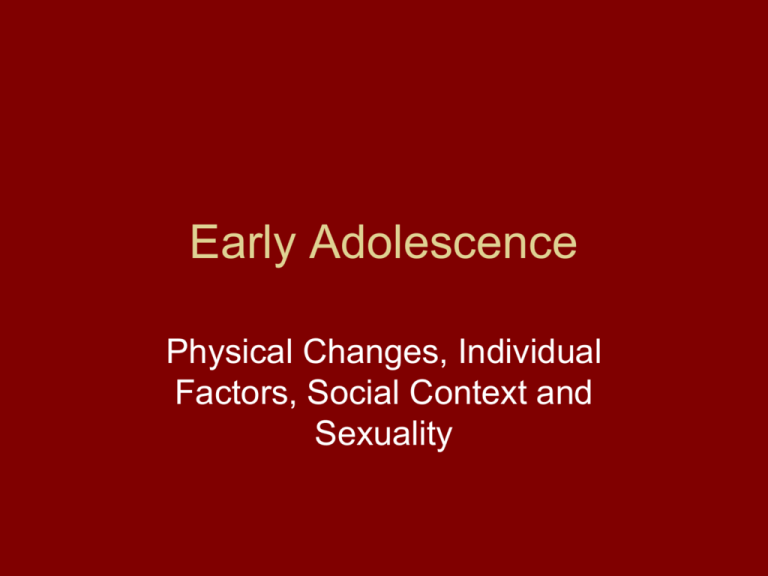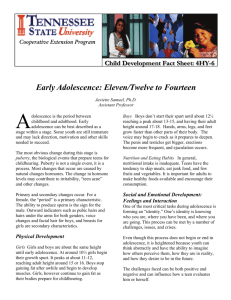
Early Adolescence
Physical Changes, Individual
Factors, Social Context and
Sexuality
Developmental Tasks
•
•
•
•
•
Physical maturation
Formal operations
Emotional development
Membership in peer group
Romantic and sexual relationships
The path from physical changes to
behaviors-figure 9.1 elaborated
Some significant physical changes
1. Puberty occurs: For girls…
•
•
•
Onset of menarche
Breast development
Increase in body fat
2. For boys…
•
•
•
Increase in muscle mass
Facial hair
Hormones
Examining the sociocultural context of
physical and sexual development
• In groups of 4-5 review several magazines in the library.
Note observations of:
–
–
–
–
Headlines
Stories
Advertisements
Images
• What, if any, are the significant patterns you see?
• What do young people learn about their physical selves?
• What do young people learn about sexuality?
Cognitive processing
(recall cognitive-behavioral concepts)
•
•
•
•
•
•
Internalized “thin ideal.”
Comparison of self with others.
Evaluation of self.
Concern with others’ perception of them.
Assignment of value.
Body image distortion.
Affect/emotional responses
•
•
Self-esteem
Body dissatisfaction-why does one NY spa
report doing 15 body waxes a week on
preteens?
–
–
–
–
40-70% of adolescents dissatisfied with 2+ aspects
of their bodies.
5% of underweight, 30% of normal weight, <7% of
boys=dissatsifaction with body.
20% of teens are overweight; 5% obese.
45% of 9th-12th grade females were dieting.
Behavioral Problems
•
•
•
•
•
Cigarette smoking
Unhealthy eating patterns
Excessive exercise
Binge eating
Purging
Considering the developmental
process in adolescence…
• Consider again the sociocultural context.
• In your group, brainstorm strategies to:
– Create a more constructive sociocultural
context.
– Innoculate young people to the negative
effects of the sociocultural context.
– Strengthen communities to support the
healthy development of youth.
Group Identity-Cognitive
Processes
1. Group representations
Map the relevant groups in your life.
2. Group operations
Identify three operations for any one of the
groups.
3. Reflective thinking about groups
What is one realization you have had
about the group?
Group Identity- Dimensions
1. Categorizing people & recognizing distinguishing
characteristics
What is one group you are not a part of?
2. Experiencing a sense of history as a group
What shared experiences do you have with this
group?
3. Emotional investment in the group
What does this group mean to you?
4. Social evaluation of one’s group and its relation to
other groups
How does this group fit in with other groups?
Consider the relevance of these concepts as
you watch Mohawk Girls.
What are some of the sexuality
related issues faced by teens?
• Brainstorm
• Some statistics (data from 2004)
– 37-61% of males between 9th and 12th grades have
had intercourse. (range)
– 28-62% of females between 9th and 12th have. (range)
– 63% of sexually active teens used a condom the last
time they had sex.
– 25% of sexually active teens contract an STI/yearly.
– Pregnancy rates: 57/1000; 90/1000 in 1955
– In the UK: 28; in China: 12; in France: 8; Japan: 5
Different Approaches
• Comprehensive Sex Education or AbstinenceBased Education
• Abstinence-Only Education
Issues
Funding
Accuracy
Effectiveness-Texas ranked 3rd in teen pregnancy;
94% of schools have abstinence-only education
Linking Sex Ed to Developmental
Process
• Cognitive Development
– Formal operational thought
• See table 9.2--2, 3, & 4
– Frontal lobe is still developing
• Judgment, reasoning, inhibition
• Physical Development
– Hormones=increased arousal and interest
– Sexual development—Self concept
– Sexual development—others’ reactions
Influences on decision making
• Motivation
• Social Controls
• Attractiveness
Conclusion: Developmental considerations
+ individual influences should guide
prevention/education approaches.
Approaches to promoting healthy
sexuality and preventing problems
Sex Ed
What to teach and when to teach it.
OR
Talking to kids
How would you respond…
In small groups…
1. You have a list of sex ed topics; arrange them
in order of age appropriateness. In other
words, which would you introduce for 12 & 13
y/os? 14 & 15? 16 and 17? Incorporate the
following into your decision making:
•
•
•
Cognitive developmental characteristics
Physical development and its impact
Motivation, social controls and attractiveness
2. Give your rationale for the order you chose.
3. Are there any you would like to exclude
altogether? Why or why not?
Answering hard questions
Cognitive-behavioral processes
• Encodings-what is a “successful teen”
• Expectancies-can I be that? What if I’m
not? What if I am?
• Affects-Empowered? Embarrassed?
• Goals/values-What is important?
• Cognitive competencies-How does one
accomplish the goal?
• Self-regulatory plans-making it happen.
Cognitive-behavioral processes
• Encodings-what is a “successful teen”
• Expectancies-can I be that? What if I’m
not? What if I am?
• Affects-Empowered? Embarrassed?
• Goals/values-What is important?
• Cognitive competencies-How does one
accomplish the goal?
• Self-regulatory plans-making it happen.
Tough Guise
• How might an adolescent’s representations of
groups be affected by the sociocultural context
described in the video?
• How might this context affect the adolescent’s
beliefs about group operations?
• What are some beliefs about group membership
that may result from exposure to this context?
Positive Youth Development
• Key points:
– An emphasis on what works.
– Strengths oriented.
– Incorporates values, morals, religion and
spirituality
• Hypotheses that should form the
foundation of work with youth.
1. Changes in context change young
people.
2. Youth are empowered and benefit when
they take action on their own behalf.
3. Both the person and the context matter.
4. Increasing the number of nutrients is
most important.
5. Nutrients help in the present as well as in
the future.
6. Community-wide efforts to build nutrients
are as important as individual, family and
organizational efforts.
7. Community level interventions will benefit
almost all youth.
Focus on Prevention
1. What do you want to prevent?
2. What do you want to promote?
3. How will you do this?
•
•
•
•
Who will you focus on?
Where will you connect with them?
How will you connect with them?
What will you do?
4. Incorporate concepts we’ve discussed
•
•
•
•
Cognitive processes relevant to group identity
Positive Youth Development/Developmental Assets
Psychosocial crisis
Event to behavior sequence model
Mohawk Girls-a movie
1. Identify linkages between individual
developmental changes and behaviors of
the girls in the film.
Or
2. Identify example from the film that are
congruent or incongruent with the
Positive Youth Development findings.
Autonomy
1. What is it?
•
•
•
•
•
Operationally define it
Separation
Connectedness
Detachment
Agency
Autonomy, cont.
2. Sociocultural influences
•
•
Cultural norms and values
Collectivist vs. individualist
Sociocultural context of changesgeneral and gender-specific
1. What do boys gain and lose as a result
of physical change?
2. What do girls gain and lose?
3. How do teens’ expectations of
themselves change as they get older?
4. How do others’ expectations of teens
change as they get older?
5. In what ways are teens valued and
validated. Or not.
Sociocultural context
What social or cultural meanings are
attached to the changes girls experience?
What do girls experience as a result?
What about to the changes boys
experience?
What do boys experience as a result?








